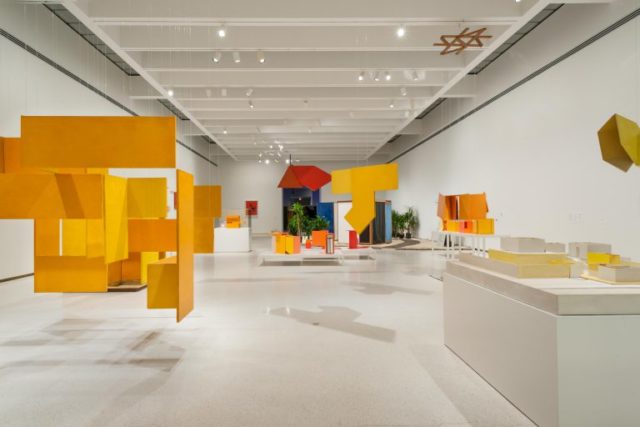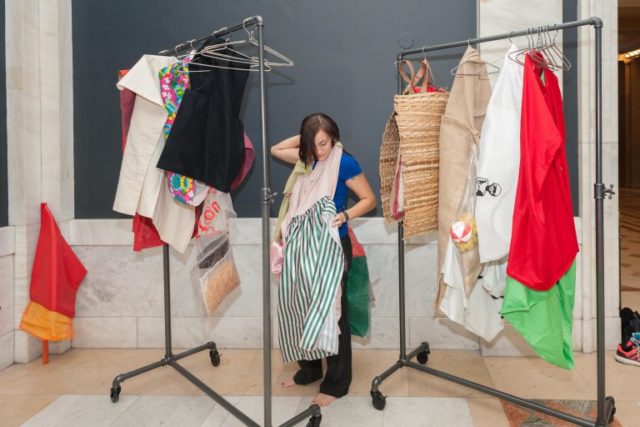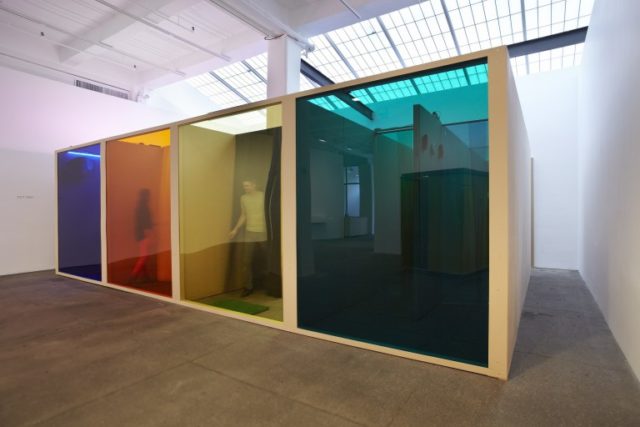
Installation view, “Hélio Oiticica: To Organize Delirium” at Carnegie Museum of Art (Photo: Bryan Conley)
Hélio Oiticica: To Organize Delirium
Carnegie Museum of Art
4400 Forbes Avenue
Pittsburgh, PA
On view until January 2, 2017
Geometric abstractions, makeshift shacks and a copious amount of sand transforms Pittsburgh’s Carnegie Museum of Art into a hippie playground for Hélio Oiticica’s retrospective To Organize Delirium (which comes to the Whitney next year). The exhibition presents a chronological look at the Brazilian artist’s short but feverishly prolific career. (He died suddenly in 1980 at 43-years old). In one gallery, a cluster of orange boards hangs from the ceiling while a cage of live parrots sits in a corner. Colorful macramé hammocks and projected images of Jimi Hendrix covered in cocaine fills another room. And the Museum’s grand Hall of Sculpture looks like a tent city on a beach.
While well-regarded in his native country, the artist remains relatively overlooked in the United States. But past the institutional visibility, To Organize Delirium doesn’t do much to rectify this. The show’s curators provide such little context for the work, which didn’t seem to age well in the first place, that I felt uncertain as to why his art had any currency at the time.
In particular, the curators seem so concerned viewer participation–an integral part of Oiticica’s art–they forgot they were curating a historical show. The wall labels contain more commands on how to maneuver through the installations than analysis that might give insight into the work. The label corresponding to one of Oiticica’s most famous installations Tropicália invites viewers to “walk through it, experience the interiors of the Penetrables and, of course, gaze at the parrots that are part of it.” In contrast, it simply contextualizes the piece as “a critique of Brazil for Brazilians.”

Installation view, “Hélio Oiticica: To Organize Delirium” at Carnegie Museum of Art (Photo: Bryan Conley)
Similar over thought yet confusing decisions around audience interaction run through the show’s entire organization. Take, for example, the treatment of Oiticica’s Parangolés. First created in 1964, his Parangolés are vibrant multi-patterned capes, made from various clashing fabrics that are occasionally emblazoned with political messages critical of Brazil’s dictatorship. While hanging on the walls, the works look like unremarkable fabric art. But with more knowledge of their concept, the Parangolés represent a radical rethinking of performance and art in the early 60’s, which had typically defined art as enduring and static like a painting or sculpture. But with the Parangolés, Oiticica redefined art as fleeting and dependent on the active participation of a wearer.
While the nearby slideshow of images of the Parangolés in motion would have been sufficient, the curators went overboard with a selection of reproductions for viewers to try on. It was a bad idea made worse in the execution. These garments weren’t displayed next to the original garments, which would have given them some much-needed context. Instead, curators relegated the capes, along with Oiticica’s interactive boxes or Bólides, to a small room on another floor. With the faux Parangolés hanging from clothing racks like a department store fitting room, the room looked more like a haphazard display in a children’s museum than a reproduction of an artist’s politically charged work.

Installation view, “Hélio Oiticica: To Organize Delirium” at Carnegie Museum of Art (Photo: Bryan Conley)
This same participatory miscalculation was further reflected in the nearby Eden installation, which resembled a giant sandbox filled with tents. Originally displayed in 1969 at London’s Whitechapel Gallery, Eden is unquestionably a product of its time. Oiticica wanted the installation to produce, what he called, “creleisure”–a mixture of leisure and creativity. The installation features several structures, offering books, music and other media to encourage relaxation.
This dopey 60’s idealism might have worked in swinging London with the aid of copious hallucinogens, but it didn’t quite mesh with the population of museumgoers in 2016 Pittsburgh. Kids screamed while kicking and tossing sand in the air. A cloud of sand swirled like a sandstorm, covering the Hall’s sculptures. It would have been laughable if it wasn’t difficult to breathe. There certainly wasn’t any “creleisure” going on. And the curators didn’t provide enough of an argument why the mess in the center of the museum was worth it.

Hélio Oiticica, “Filter Project—For Vergara (Projeto Filtro—Para Vergara),” 1972, nylon, acrylic, plastic curtains, natural fiber doormat, television set, tape recorders, transistor radio, buzzer, orange juice machine, fluorescent lamps, and fiberboard ((c) Projeto Hélio Oiticica, Rio de Janeiro. Courtesy Projeto Hélio Oiticica, Rio de Janeiro and Galerie Lelong, New York)
The interactive works in the Hall of Sculpture were just one of the installations that missed the mark. Several of the works in the galleries didn’t just fail to live up to their description on the wall labels, they failed to correspond at all. Take Oiticica’s 1972 Filter Project–For Vergara that the label explained was “designed to bombard the senses.” From the outside, the installation looked potentially overwhelming like a maze of multicolored rooms, separated by several curtains. But inside, the occasional TV and radios were turned down so low they were barely audible, which doesn’t provide much of a sensory assault.
Was the silence and disappointment of Filter Project–For Vergara a failure of execution on the part of the curators or Oiticica’s original? I couldn’t find a definitive answer since the archival contextualization of the installation was a small video of the work on view at Galerie Lelong in 2012. I assume an installation from four years ago wouldn’t be significantly different–and it wasn’t.
Similar recent video footage could be found near other installations in the show. It just appeared like a desperate attempt to add weight to poorly constructed installations by touting their exhibition history. But it wasn’t enough. In a historical exhibition like To Organize Delirium, the audience, at bare minimum, should come away with a clear idea of the merit of the work. And with what little the curators gave viewers to work with at the Carnegie, I didn’t leave with even that.


Comments on this entry are closed.